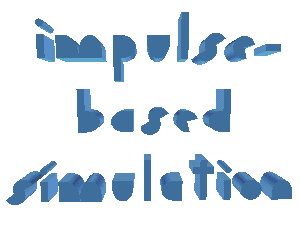Introduction
According to Brian Mirtich, the
primary developer of the serial version of the rigid body dynamic
simulator named Impulse:
 "Impulse-based simulation is a new paradigm for the simulation of
physical systems, especially those which are hard to simulate
efficiently with traditional constraint-based methods. The key idea is
that all contact interactions between objects are affected through
collisions; even a block apparently at rest on a table actually
experiences many tiny, rapid collisions with the surface."
"Impulse-based simulation is a new paradigm for the simulation of
physical systems, especially those which are hard to simulate
efficiently with traditional constraint-based methods. The key idea is
that all contact interactions between objects are affected through
collisions; even a block apparently at rest on a table actually
experiences many tiny, rapid collisions with the surface."
The serial version of Impulse consists of over 27,000 lines of C code
written by Brian Mirtich. For its parallel implementation the code
was converted to Split-C
by Eric Paulos. There were various
modifications and additions made to Impulse in Split-C for parallel
execution. Many of these changes are discussed in the parallel section of this writeup. The
parallel version of Impulse has been compiled and executed on both the
CM5
and the SP1
architectures.
A classically difficult simulation example is that of a pool break.
Brian Mirtich describes how Impulse handles this system correctly.
"This simulation involves breaking a rack of fifteen pool balls with a
high velocity cue ball. Constraint-based simulators have trouble with
this example because of the large number of mutual contacts between
the racked balls. David
Baraff has shown that the problem of finding a set of contact
forces that instantaneously obey the Coulomb friction law at every
contact point is NP-hard. Furthermore, the contacts are quite
transient in time, making it difficult for a constraint-based
simulator to integrate the system.
The impulse-based method avoids these problems by treating the mutual
effects of the balls on each another as a series of closely spaced
collisions. For this simulation, the racked balls (which were the
size of standard pool balls) were initially placed 0.1 millimeters
apart, already within each other's collision envelopes. Thus, when
the cue ball strikes the rack, many collisions occur before the balls
even begin to move. A movie of the simulation results by Brian
Mirtich is here."
Eric Paulos /
paulos@robotics.eecs.berkeley.edu /
10 May 1995
 "Impulse-based simulation is a new paradigm for the simulation of
physical systems, especially those which are hard to simulate
efficiently with traditional constraint-based methods. The key idea is
that all contact interactions between objects are affected through
collisions; even a block apparently at rest on a table actually
experiences many tiny, rapid collisions with the surface."
"Impulse-based simulation is a new paradigm for the simulation of
physical systems, especially those which are hard to simulate
efficiently with traditional constraint-based methods. The key idea is
that all contact interactions between objects are affected through
collisions; even a block apparently at rest on a table actually
experiences many tiny, rapid collisions with the surface."